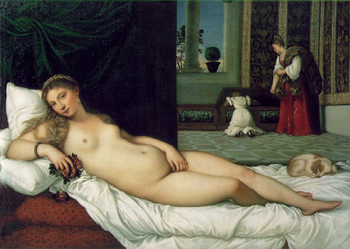| Search Art Prints | ||||||||||||||||||||
| Search Artists | ||||||||||||||||||||

|
||||||||||||||||||||
|
|
|||||||||||||||||||

Venus of Urbino

|
Venus of Urbino
As a leading master of the Italian Renaissance, Titian would not only impact his immediate successors but much of Western art to follow. One of his most famous paintings was a piece commissioned by Duke Guidobaldo della Rovere. Titled Venus of Urbino, the painting is among the most provocative and enigmatic works of art of all time.
While sixteenth century Italians were certainly accustomed to nude portraits, Titian's Venus of Urbino came as quite a shock. Patterned after his mentor Giorgione's Sleeping Venus, the two paintings have one key difference. In Sleeping Venus, the subject is fast asleep and in Venus of Urbino, she is as awake as can be. Not content with having the viewer gaze placidly at a slumbering subject, he instead returns the gaze with his seductive, mysterious Venus.
Ironically, while the painting is titled Venus of Urbino, it is not clear whether Titian intended for his subject to be taken as the mythological goddess. The flowers his subject holds in her right hand might recall Venus' penchant for spring, however the background of the painting is clearly not Roman but Renaissance. It is possible that Titian modeled his subject after his patron's young wife Giulia, although this has never been proven.
In addition to the identity of his subject, the symbolism within Titian's Venus of Urbino has also been a topic of great debate. Duke Guidobaldo originally intended the painting to be a wedding present for his new bride Giulia, however Titian's masterpiece would seem to appear decidedly non-matrimonial. Despite this, many critics have theorized that the sleeping dog and the girl and woman in the background symbolize loyalty and domesticity.
Analysis and Reviews
Regarded by most authorities as a paragon of High Renaissance art, the highly sensual nature of Venus of Urbino has earned it its fair share of detractors. In his book Tramp Abroad, Mark Twain wrote, “There are pictures of nude women which suggest no impure thought -- I am well aware of that. I am not railing at such. What I am trying to emphasize is the fact that Titian's Venus is very far from being one of that sort. Without any question it was painted for a bagnio and it was probably refused because it was a trifle too strong. In truth, it is a trifle too strong for any place but a public art gallery.”
Venus of Urbino is currently located at the Galleria degli Uffizi in Florence.











